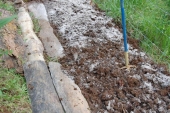Here is a video about making a hugelkultur bed in western Montana, a slightly more arid place than most of the Pacific Northwest. It covers start to almost finished, along with some other video about a few different parts of our permaculture farm and surroundings. I don't expect that many people will watch the whole thing. I plan to do an update in the Spring when we are ready to plant on the bed, and more updates throughout the growing season. Since making this video, we have had a few breaks in the freezing weather and the ground thawed out enough that we have been able to continue building the hugelkultur bed up towards the desired height. Underneath the video you can read a six-point description of the benefits of hugelkultur over flat land, row crop growing.
Hugelkultur is a German word that means "mound culture," and this is a way of cultivating crops on mounds of earth, wood and natural nutrients that has several benefits over planting in conventional flat rows:
1. With the vertical rise of the mound and the high amount of fertile nutrients built into it, you can grow more food in a smaller area.
2. The wooden logs and branches, along with large leafy material like comfrey, built into the hugelkultur mound absorb and hold water, thus requiring less watering by the gardener or farmer. I have heard several users of this method say they only have to water their hugelkultur beds about twice during the entire growing season.
3. This is another great example of why we do not need to use toxic chemicals or ANY commercial fertilizers to grow the healthiest crops possible. The hugelkultur beds can contain a large quantity of all varieties of natural plant fertilizer/nutrients, arranged to decompose at different rates and provide very fertile soil for several years, without having to add anything but a little bit of water. The nutrients in the hugelkultur mound in this film include: bison and cow manure, a little bear poop, compost, comfrey, other plant materials, topsoil, and small rocks.
4. The taller the mound, the less bending over or kneeling the farmer or gardener needs to do, which of course greatly reduces back, knee and joint pains.
5. This method is less labor-intensive than conventional flat-ground row gardening, since it requires less watering and is easier to access for weeding, harvesting and general management.
6. The benefits and pleasure gained from this method of cultivating crops serves to provide greater encouragement and higher motivation to grow our own healthy food and live healthier lives.









 1
1




































































